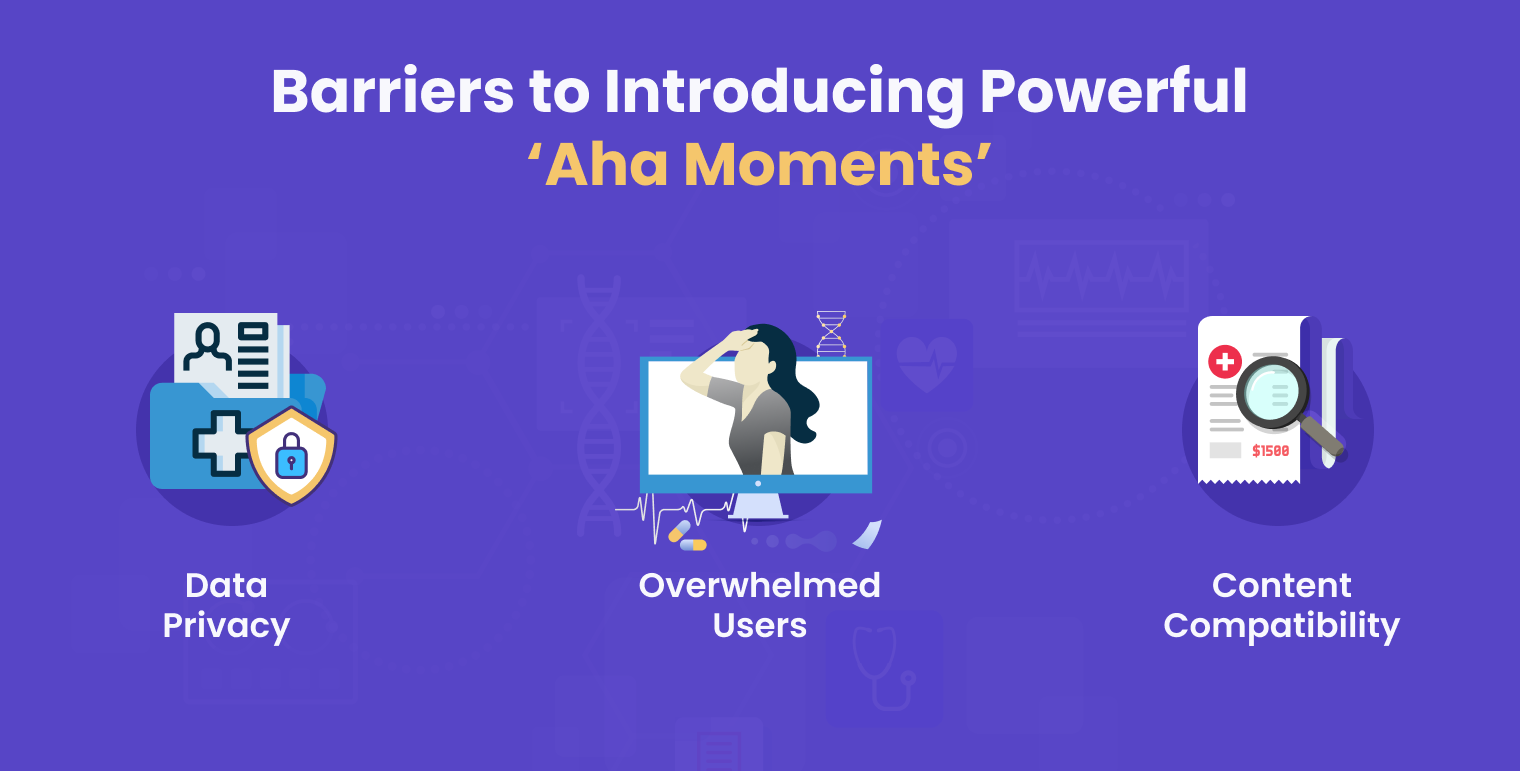In marketing, the term ‘Aha moment’ encapsulates that instance when a person comprehends the true essence and value of a product or service. It is the turning point where the pieces of the puzzle come together and a profound realization sparks. It could happen at any moment in the customer journey- starting with their onboarding experience, personalization, impact, and emotional connection. This phenomenon isn’t limited to mere enlightenment; it’s the catalyst for sustained engagement and lasting connections.
When transposed into the world of healthtech, the concept of the ‘Aha moment’ takes on a profound significance. Beyond the initial encounter, healthtech firms endeavor to forge enduring relationships with users. This blog examines the ‘Aha moment’, delving into its origins while offering a glimpse into how it transforms downstream engagement in the dynamic landscape of health technology.
Understanding Downstream Engagement in HealthTech
In the process of user interaction, downstream engagement is vital. This term encapsulates the series of interactions, experiences, and connections that extend beyond the initial touchpoint. Downstream engagement is the journey beyond the first impression, where users transition from curious explorers to committed participants.
For healthtech firms, downstream engagement is a strategic imperative. It’s the roadmap that transforms passive users into active advocates. By nurturing this engagement, healthtech companies cultivate a sense of loyalty and trust among users, fostering a symbiotic relationship built on value and reliability. For healthtech, downstream engagement can take on many forms, including personalized health recommendations tailored to individual needs, timely medication reminders that genuinely make a difference, and insightful wellness insights delivered at the right moment.
In this context, the significance of downstream engagement is twofold. Firstly, it fuels user retention, combating the ephemeral nature of fleeting attention spans. Secondly, it paves the way for comprehensive user understanding, facilitating personalized experiences that resonate profoundly. In the landscape of healthtech, where trust and authenticity are paramount, downstream engagement isn’t just a concept – it’s the cornerstone upon which lasting success is built.
The Quest for the ‘Aha Moment’
Defined as the pivotal instant when users grasp the profound value of a healthtech solution, the ‘Aha moment’ is the bridge between intrigue and engagement, turning skeptics into enthusiasts. The healthtech ‘Aha moment’ isn’t merely about convenience or curiosity—it’s about personal well-being. It’s the instant when a user perceives tangible improvements in their health or quality of life, creating an emotional connection that lasts beyond the digital realm.
Imagine a diabetes management app that assists users in achieving consistent blood sugar levels, providing them with a visual representation of their progress.
Or consider a wearable fitness tracker that not only records steps but also celebrates personal milestones, fostering a sense of accomplishment and dedication. In healthtech, these could potentially be Aha Moments. Further in this blog, we will discover the various Aha Moments that can happen in downstream engagement in healthtech.
The event that Sparks the ‘Aha Moment’
The journey to the ‘Aha moment’ begins with pinpointing the trigger points that resonate with users. This trigger could be a seamless integration of a health monitoring device, a data-driven health assessment that aligns with personal goals, or even a visually compelling representation of progress.
Several factors contribute to this pivotal instant.
First, relevance – the ‘Aha moment’ hinges on aligning the healthtech solution with the user’s unique needs and aspirations.
Second, usability – simplicity and intuitiveness play a significant role in ensuring users can effortlessly navigate and derive value from the solution.
Third, demonstrable impact – the ‘Aha moment’ flourishes when users witness tangible improvements in their health or well-being.
To substantiate the power of these factors, let’s delve into use cases that exemplify transformative ‘Aha moments’ in healthtech. A mental wellness app (such as CopeSmart) might provide personalized coping mechanisms in real-time, fostering emotional resilience, and showcasing the impact of relevance and usability. Similarly, the journey of a virtual physical therapy platform (like ReWalk Robotics) that allows users to track their progress, culminating in enhanced mobility, underscores the significance of demonstrable impact.
As healthtech firms meticulously identify these trigger points, harnessing the factors that fuel the ‘Aha moment,’ they sculpt experiences that resonate, empower, and foster sustained engagement. Through these use cases, we witness the tangible results of strategic orchestration, validating the potency of this pivotal event in shaping downstream engagement dynamics. It takes a strategic approach built on three main pillars to achieve the ideal ‘Aha moment’ in health technology.
Studying How People Actually Use Your Product
Healthtech companies must carefully examine user behaviour and preferences in order to craft a ‘Aha moment’ that is truly memorable. Data from users’ interactions with the platform, including which features they prefer and where they run into problems, must be gathered and analyzed. Healthtech businesses can better meet the needs of their customers if they take the time to analyze data and look for trends and points of frustration.
Using Individualization and Information-Based Understanding
The key to achieving that ‘Aha!’ moment is to make it uniquely yours. By analyzing user data, healthtech companies can tailor solutions to meet the specific requirements of their customers. Some examples of this would be giving specific advice on how to improve one’s health, providing individualized workout programs, or giving instant feedback on one’s progress. The ‘Aha moment’ is elevated from being a generic concept to being a profoundly relevant and impactful event through the use of personalization.
Using Technology To Help People Have ‘Aha!’ Moments
Technology in the modern era makes it possible for us to have truly remarkable ‘Aha!’ moments. To better serve their customers, healthtech companies can use modern technologies like AI and machine learning to automate personalized interactions and provide timely insights. Whether it’s a wearable device that monitors vital signs or a mobile app that provides instantaneous nutrition advice, technology plays a critical role in setting the stage for that lightbulb moment.
By analyzing user behavior, customizing solutions, and incorporating cutting-edge technology, healthtech companies can create ‘Aha!’ moments with lasting impact. As time goes on, these occurrences don’t just stand alone; they become part of a continuous, user-centric journey that keeps people interested, knowledgeable, and inspired as they work towards improved health.
Measuring Success: Metrics and Outcomes
A keen eye on specific metrics and outcomes is required to measure success in the pragmatist world of healthtech. Healthtech firms can use these metrics as a compass to determine how well their downstream engagement strategies are faring.
Measures of Success for Assessing Aftermarket Participation
- Long-term user retention is an indicator of a health tech platform’s success. When customers stick with a service, it’s because they continue to enjoy using it.
The success of your onboarding and subsequent engagement efforts can be gauged by monitoring the percentage of users who convert from an initial engagement (such as signing up) to a desired action (such as subscribing or using premium features). Long-term monitoring of user activity is just as important as initial interactions. User engagement can be measured in many ways, including how often and for how long users interact with the app and which features they choose to use. - Monitoring Long-Term Engagement, Conversion Rates, and User Retention
After the initial ‘aha!’ moment, healthtech companies need to figure out how to keep users interested in their products. A high rate of user retention suggests that the service or product offers value beyond the initial attraction. - Conversion rates: the link between curiosity and dedication. One crucial metric for gauging the efficacy of the ‘Aha moment’ and subsequent engagement strategies is tracking the percentage of users who go from casual engagement to taking meaningful actions.
- User Dedication Over Time: This is the ultimate indicator of success. Indicators that the ‘Aha moment’ has turned into an ongoing journey include frequent use, consistent interactions, and continued engagement with the healthtech solution.
Success in the healthtech industry can be measured against the standards and methods employed by established companies. Analyzing how these companies use data, improve personalization, and keep users engaged after the ‘Aha!’ moment can teach other businesses valuable lessons.
In a nutshell, healthtech success indicators are transparent and quantifiable. Concerns like long-term participation, conversion rates, and user retention are central. Healthtech companies can improve their downstream engagement strategies by keeping a close eye on these metrics and learning from the best in the business, thereby increasing the likelihood that the ‘Aha moment’ will occur and serve as a catalyst for long-term user loyalty.
Overcoming Challenges and Pitfalls
There are a number of common challenges and pitfalls that arise when trying to create meaningful ‘Aha moments’ and ensure sustainable downstream engagement in health technology. It is crucial to identify these challenges if you want to achieve your goals. In this article, we delve into these challenges and offer advice for overcoming them:
Frequent Barriers to Introducing Powerful ‘Aha Moments’
Data Privacy: Health information is extremely personal and must be protected at all costs. Finding a happy medium between user privacy and customization is difficult. The abundance of health-related data and tools has the potential to confuse and disengage users.
Overwhelmed Users: These are problems arising from a lack of tech-savvy users. It’s crucial to make sure that technology doesn’t get in the way of participation.
Content Compatibility: It can be challenging to provide content and suggestions that are truly applicable to each user’s individual health journey.
Methods for Overcoming Obstacles and Maintaining Participation in the Downstream
Data security must be a top priority, so be open and honest about how you’re handling sensitive information. Users should be able to view and edit their own data and choose whether or not to participate in personalized features.
Enhance the User Experience by streamlining interfaces, providing guided onboarding, and establishing straightforward paths to the most important features. The design must be intuitive.
Invest in initiatives aimed at educating users about the technology, such as tutorials, frequently asked questions, and customer support.
Enhance Recommendations’ Relevance by constantly tuning algorithms and AI Models dedicated to personalization. Let people comment on posts and offer ideas for improvements.
Conscious design, user agency, and constant iteration are essential to overcoming these obstacles and producing lasting ‘Aha!’ moments and downstream engagement.
If a healthtech company can overcome these challenges, it will be in a great position to provide long-term value and user engagement.
Future Trends: Evolving the ‘Aha Moment’ in HealthTech
The landscape of healthtech is in a constant state of evolution, and the concept of the ‘Aha moment’ is not immune to this transformation. As we peer into the future, several trends and innovations are poised to redefine downstream engagement dynamics:
Anticipated Shifts in User Expectations and Technology
Hyper-Personalization: Users will expect healthtech solutions to not only cater to their unique health needs but also adapt in real time to changing circumstances.
Seamless Integration: Healthtech platforms will become more integrated with users’ daily lives, seamlessly connecting with wearables, smart homes, and other devices to provide a holistic health ecosystem.
AI-Powered Insights: Artificial intelligence and machine learning will play an increasingly prominent role in delivering predictive health insights, enabling users to proactively manage their well-being.
Innovations That Could Redefine Downstream Engagement Dynamics
Telehealth Evolution: The convergence of telehealth with healthtech will create new ‘Aha moments’ through virtual consultations, remote monitoring, and AI-assisted diagnostics.
Genomic Health: As genomic information becomes more accessible, healthtech will offer personalized recommendations based on an individual’s genetic profile.
Behavioral Health Emphasis: Healthtech will pivot towards addressing mental health, leveraging AI for early detection and intervention in conditions like depression and anxiety, with mental health EHR systems streamlining patient data management.
These anticipated shifts and innovations in user expectations and technology will undoubtedly reshape the ‘Aha moment’ in healthtech. Healthtech firms that adapt and harness these trends will be well-positioned to deliver even more profound and lasting downstream engagement, ushering in an era where health and technology merge seamlessly for the benefit of all.
Conclusion
In summary, the ‘Aha moment’ in healthtech holds significant importance. It serves as a pivotal point where users realize the value of a healthtech solution, leading to sustained engagement and trust. The ‘Aha moment’ is more than just an insight; it’s the foundation of user engagement in healthtech. It marks the transition from curiosity to a commitment to better health.
We strongly recommend that healthtech businesses make the ‘Aha moment’ a central part of their user engagement strategy. Understand that this is not a one-and-done occurrence but rather a process. Make the most of this transformative moment by overcoming obstacles, making use of technology, and adjusting to users’ expectations.
Also, book a demo with WebEngage if you need hands-on help improving your user engagement efforts. A top retention marketing platform, they know how to create meaningful ‘Aha moments’ in the healthtech industry. Find out how their products can boost your downstream engagement strategies and enhance your users’ overall experience.
In healthtech, the ‘Aha moment’ is more than just a concept; it’s a key part of making a connection between technology and user health. Participation, trust, and improved user health will flourish under your care.


































 Kasturi Patra
Kasturi Patra
 Inioluwa Ademuwagun
Inioluwa Ademuwagun
 Surya Panicker
Surya Panicker



